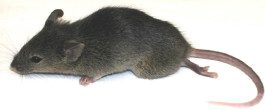

Small animal models for virus infection are of great value for studying viral pathogenesis, testing new vaccines, and developing antiviral drugs. However, mice are often not susceptible or permissive for infection by many important viruses. For example, mice and mouse cells are permissive for poliovirus replication, but are not susceptible to infection with the virus. Mice can be made susceptible to poliovirus infection by transgenic expression of the human poliovirus receptor. In a similar way, a transgenic mouse model for measles virus infection has been produced. But it has been far more difficult to create transgenic mice susceptible to other important viruses, including HIV-1 and hepatitis C virus (HCV).
Mouse cells are permissive for HCV replication (the viral RNA can replicate when transfected into cells), but they are not susceptible: for example, they cannot be infected by lentiviral particles bearing HCV glycoproteins. Three cellular proteins required for HCV entry into cells were previously identified: CD81, scavenger receptor class B type I or SCARB1, and claudin-1. Most recently a fourth cellular protein, occludin, was found to be essential for HCV entry into cells. HCV can enter mouse cells that synthesize human occludin and CD81; apparently the murine versions of SCARB1 and claudin-1 can promote HCV entry. The human versions of these four proteins was sufficient to confer permissivity to HCV entry in a variety of human, murine, or hamster cell lines.
Because the major block to HCV entry in murine cells can be overcome by synthesis of human CD81 and occludin, will it now be possible to produce transgenic mice susceptible to HCV? Perhaps not yet: there are other blocks to HCV replication in murine cells. For example, viral RNA replication in mouse cells is not efficient, nor has assembly of infectious virions been demonstrated. But these problems can now be readily addressed, and I would not be surprised to find that CD81/occludin transgenic mice already exist and are being tested for susceptibility to HCV in at least one laboratory.
Ploss, A., Evans, M., Gaysinskaya, V., Panis, M., You, H., de Jong, Y., & Rice, C. (2009). Human occludin is a hepatitis C virus entry factor required for infection of mouse cells Nature, 457 (7231), 882-886 DOI: 10.1038/nature07684

scary..
Can you comment on difference between permissive cells verses susceptible cells?
Susceptible cells have the receptor for the virus. In permissive
cells, the complete viral replication cycle can occur, leading to the
production of new virions. A cell must be both susceptible and
permissive in order for the complete replication cycle to occur. For
example, mouse cells are permissive for poliovirus replication because
the viral RNA will replicate if introduced into these cells. However,
the cells are not susceptible, because they lack a receptor for the
virus.
Can you comment on difference between permissive cells verses susceptible cells?
Susceptible cells have the receptor for the virus. In permissive
cells, the complete viral replication cycle can occur, leading to the
production of new virions. A cell must be both susceptible and
permissive in order for the complete replication cycle to occur. For
example, mouse cells are permissive for poliovirus replication because
the viral RNA will replicate if introduced into these cells. However,
the cells are not susceptible, because they lack a receptor for the
virus.
Pingback: hepatitis a virus
Uhh thats severe.I afraid mouse and that type of infections.Anyways i read the whole article and will be thinking more on it for getting rid of it.
promotional gifts